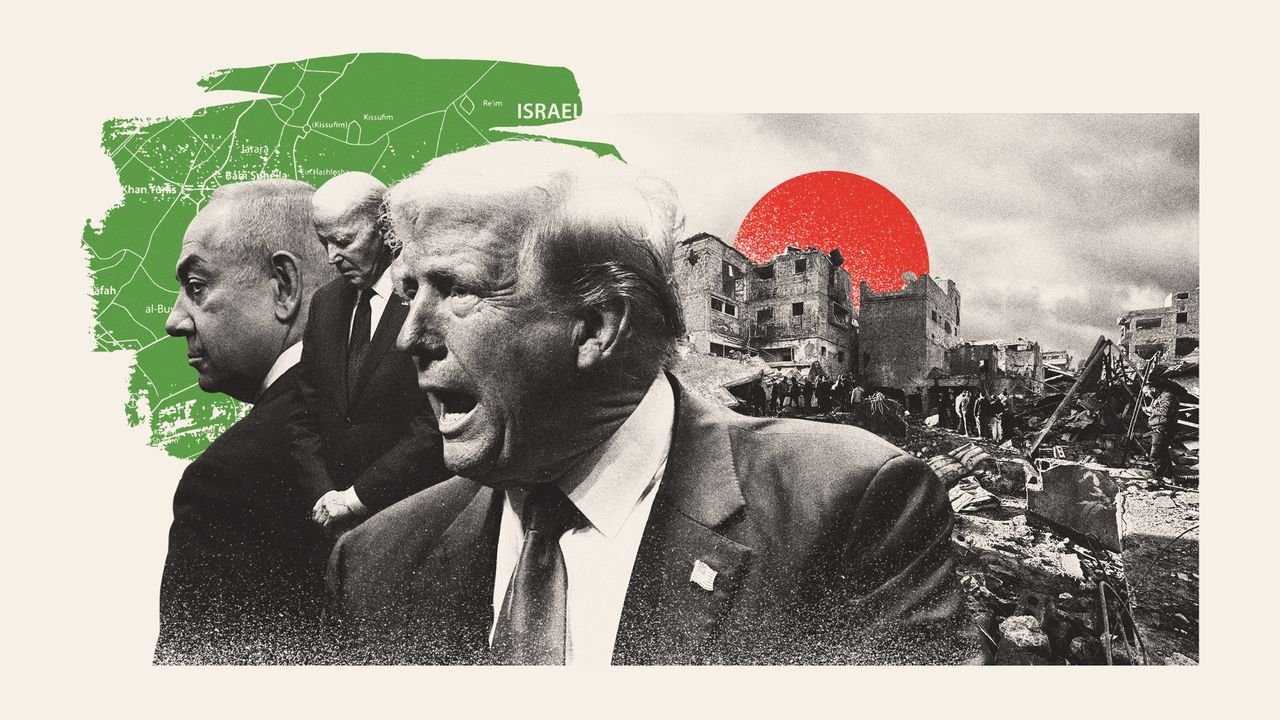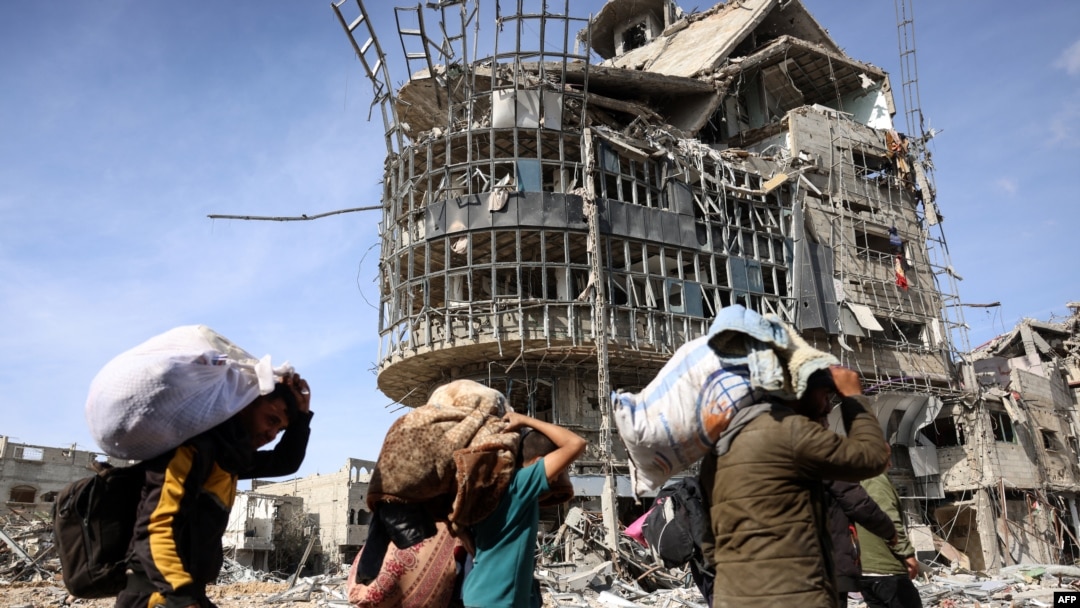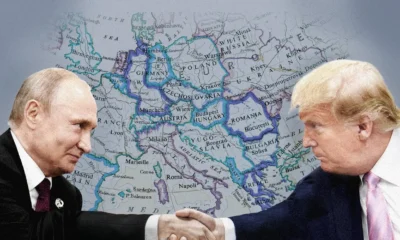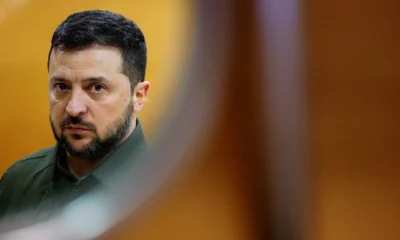Politics
The Fragile Israel-Gaza Ceasefire. Trump’s Call For Gaza Exodus To Jordan And Egypt. Was The Agenda Always To “Clean Out” Gaza By Turning Its People Into Refugees?
Published
9 months agoon

The fragile Israel-Gaza ceasefire, mediator Qatar announced early Monday that an agreement has been reached to release an Israeli civilian hostage and allow Palestinians to return to northern Gaza, addressing a critical point in the tenuous ceasefire between Israel and Hamas.
According to Qatar’s statement, Hamas will release Arbel Yehoud, an Israeli civilian hostage, along with two others, by Thursday. Israeli authorities confirmed that, starting Monday, Palestinians would be permitted to return to their homes in northern Gaza.
The ceasefire deal, initially stipulating the return of Palestinians to northern Gaza on Saturday, faced delays after Israel demanded the release of Yehoud, which Hamas had reportedly not fulfilled as scheduled. Hamas accused Israel of breaching the agreement by halting the return process.
The Israeli Prime Minister’s Office confirmed the timeline for the hostage release and stated it had received a list of hostages to be freed in the six-week initial phase of the ceasefire. Hamas also declared that it had provided detailed information about all hostages to Israeli authorities.
Meanwhile, thousands of Palestinians have gathered near the Netzarim corridor, the main route dividing Gaza, awaiting permission to return north. Tensions escalated on Sunday when local health officials reported that Israeli forces fired on the crowd, resulting in two fatalities and nine injuries.
Dispute and Shootings Strain Fragile Ceasefire in Gaza
Israeli forces opened fire on crowds in three separate incidents from Saturday night into Sunday, killing two individuals and wounding nine others, including a child, according to Al-Awda Hospital, which treated the casualties.
In a statement, the Israeli military said warning shots were fired at “several gatherings of dozens of suspects advancing toward troops and posing a threat.”
The ceasefire, in effect since last Sunday, has seen Israel withdraw from several areas in Gaza. However, the military continues to maintain a presence in a buffer zone along the border and the Netzarim corridor, warning civilians to keep their distance from troops operating in these areas.
Hostage Exchanges Amid Tensions
On Saturday, Hamas released four female Israeli soldiers, while Israel freed approximately 200 Palestinian prisoners, many serving life sentences for deadly attacks. However, tensions escalated as Israel criticized Hamas for failing to release Arbel Yehoud, a civilian hostage whose release was expected earlier under the agreement.
Hamas assured mediators from the U.S., Egypt, and Qatar that Yehoud was alive and provided guarantees for her release. The delay has led to frustrations among displaced Palestinians waiting to return north, many of whom are enduring harsh winter conditions.

Challenges to Ending the War
The ceasefire aims to conclude the 15-month conflict that began with Hamas’ October 7, 2023, attack on Israel. It includes provisions for freeing hostages in Gaza in exchange for Palestinian prisoners. However, significant challenges remain.
Around 90 hostages are believed to still be in Gaza, with Israeli authorities estimating that up to half may have died. The first phase of the ceasefire, which runs until early March, includes the release of 33 hostages and nearly 2,000 Palestinian prisoners. Negotiations for the second phase, which Hamas has linked to a complete end to the war, have yet to begin.
Some Israeli ministers advocate for resuming military operations, a stance criticized by families of hostages. “Any resumption of fighting is a death sentence for the hostages”.
Trump’s Call for Gaza Exodus
In a polarizing statement aboard Air Force One, United States President Donald Trump suggested relocating Gaza’s population to Egypt and Jordan as a resolution to the enduring Israeli-Palestinian conflict. This provocative idea, described by Trump as a plan to “just clean out” Gaza, has drawn sharp criticism, evoking concerns about human rights, historical injustices, and regional stability.
The Proposal. Mass Displacement as a Solution?
Trump’s comments followed discussions with Jordan’s King Abdullah II and plans to speak with Egypt’s President Abdel Fattah el-Sisi. He proposed that Egypt and Jordan take in displaced Palestinians from Gaza, a densely populated territory with 2.3 million residents.
Trump complimented Jordan for its history of accommodating Palestinian refugees and urged it to take in more, calling Gaza “a real mess.” He described the potential relocation as temporary or possibly long-term.
This suggestion, however, was met with widespread condemnation. The Palestinian Islamic Jihad (PIJ) labeled the proposal as an endorsement of “war crimes,” emphasizing that it aligns with the agenda of the far-right Zionist movement and denies Palestinians their rightful existence. Similarly, Egypt and Jordan rejected the notion, reaffirming their commitment to the two-state solution and the Palestinians’ right to remain on their land.
Regional Reactions
Egypt, which has long opposed the forced displacement of Palestinians, reiterated its stance through a statement from its foreign ministry. It illuminated the importance of preserving Palestinian rights and rejected any plans that might lead to the depopulation of Gaza. Egyptian President Abdel Fattah el-Sisi warned that such displacement would threaten Egypt’s national security and undermine the peace treaty signed with Israel in 1979.
Likewise, the Arab League echoed these sentiments, condemning the proposal as ethnic cleansing.
Jordan, already home to 2.3 million registered Palestinian refugees, firmly opposed the idea. Foreign Minister Ayman Safadi reiterated that “Jordan is for Jordanians and Palestine is for Palestinians,” emphasizing the kingdom’s rejection of any forced displacement.
Palestinian Authority President Mahmoud Abbas condemned any plans to relocate Gaza’s residents, stressing the Palestinian people’s unwavering connection to their land and holy sites. Abbas’s statement reflects the collective sentiment of a population that has endured decades of displacement and conflict.

Echoes of the Nakba
For Palestinians, Trump’s proposal evokes painful memories of the Nakba, or catastrophe, when hundreds of thousands were displaced during the establishment of Israel in 1948. Most Gazans today are descendants of those refugees, and any attempt to displace them again would deepen the historical wound and further tensions.
Abdullah Al-Arian, a history professor at Georgetown University in Qatar, spoke of the longstanding attempts to push for the mass displacement of Palestinians. He noted that such proposals are politically unviable and unlikely to gain acceptance from Arab leaders or the Palestinian people, who remain resolute in their connection to their homeland.
Support from Israeli Hardliners
However, far-right Israeli Finance Minister Bezalel Smotrich praised Trump’s idea, calling it “out-of-the-box thinking” that could lead to peace and security. Smotrich suggested creating opportunities for Palestinians to build better lives elsewhere, framing the displacement as a chance for renewal. However, this perspective contrasts with the international outcry and the resistance of the Palestinian population.
Meanwhile, in a calculative move, Trump also announced the lifting of a hold on the delivery of 2,000-pound bombs to Israel, a move that has sparked further controversy. These bombs, known for their devastating impact, were previously withheld by the Biden administration due to concerns over civilian casualties.
Was the Agenda Always to “Clean Out” Gaza by Turning Its People into Refugees?
The fragile ceasefire in Gaza, which followed months of unrelenting conflict, has ostensibly provided a respite from the violence. Yet, it has also brought to light a contentious and deeply unsettling question – Is the ceasefire a pretext to forcibly displace its population, turning a humanitarian crisis into a refugee exodus to neighboring Egypt and Jordan? (If they had indeed agreed)
Trump’s suggestion to “just clean out” Gaza and relocate its 2.3 million residents to Egypt and Jordan raise uncomfortable questions about whether the conflict was ever intended to achieve peace or if it was part of a larger agenda to fundamentally alter the demographics of the region.
A Ceasefire with Strings Attached?
The ceasefire, brokered amid global pressure, is widely seen as a pause in the devastation rather than a step toward lasting peace. It followed a war that left Gaza in ruins, displacing nearly all its residents. Trump’s comments about relocating Gazans to Egypt and Jordan align with a ‘narrative’ that some Israeli officials and far-right politicians have subtly (or overtly) endorsed over the years – a desire to “solve” the Gaza problem by emptying it of its people.
For Palestinians, the prospect of mass displacement evokes fears of ethnic cleansing.
Critics argue that the destruction of Gaza’s infrastructure and the displacement of its people may not have been unintended consequences of the war but rather the objectives themselves. Gaza has been described as an “open-air prison,” with its residents subjected to blockades, airstrikes, and economic strangulation for years. The recent conflict, with its unprecedented scale of destruction, has rendered much of Gaza uninhabitable.

The Two-State Solution, A Mirage?
The notion of a two-state solution has been the cornerstone of peace negotiations for decades. However, the reality on the ground—continued settlement expansion, the blockade of Gaza, and the erosion of Palestinian sovereignty—makes this increasingly untenable. If the war on Gaza was indeed a calculated move to displace its population, it represents a direct assault on the viability of a Palestinian state.
The Last Bit
The ceasefire has brought temporary relief but no real solutions. The rebuilding of Gaza will take years, and its people face an uncertain future. Trump’s comments, coupled with far-right Israeli rhetoric, suggest that the war’s endgame may not be peace but a demographic reshaping of the region.
Was the war on Gaza a deliberate attempt to depopulate the territory under the guise of conflict? The answer lies not only in the actions of world leaders but also in the resilience of the Palestinian people and the global community’s willingness to uphold principles of justice and human rights.
If the Israel-Gaza ceasefire was merely a prelude to a larger displacement agenda, the world must ask itself whether it is willing to stand by and watch history repeat itself—or whether it will act to prevent another Nakba.
You may like
-


Taiwan’s ‘Historic’ TSMC Deal, A Win Or The End Of Its ‘Silicon Shield’ As China Threatens? A Jittery Taiwan Watches Trump’s Moves On Ukraine, Wondering, Could We Be Next?
-


America And China’s Thirst For Gold In 2025 Is Draining Other Countries’ Reserves; Here’s Why?
-


Germany’s Friedrich Merz’s Big Balancing Act—Trump, Borders & Europe’s Future. Can He Deliver?
-


United Kingdom To Unleash Its ‘Harshest’ Sanctions On Russia Yet—But Will They Bite? How Trouble Is Brewing For Keir Starmer At Home. Shamed For Volunteering British Troops In Ukraine
-


How It’s Not Trump But Vladimir Putin That Europe Is Stinging From: Trump’s U-Turn On Europe, Russia’s Strong Supply Chain—A Formidable Opponent!
-


Is Ukraine Now Stuck In The US-Russia Ecosystem? Could Zelensky Have Made A Deal To Stop The War, Is Trump Right?
